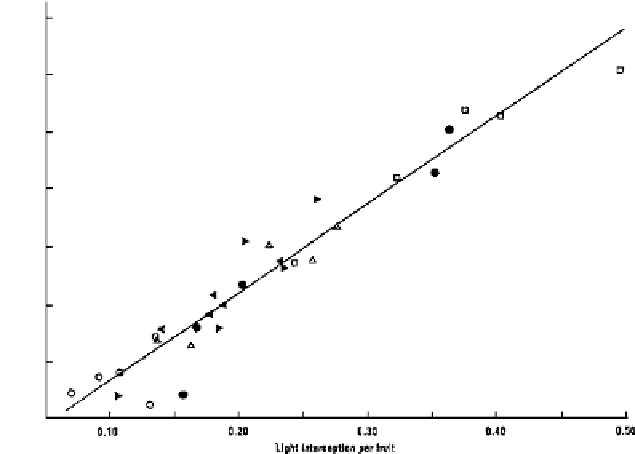Agriculture Reference
In-Depth Information
200
160
120
80
0.10
0.20
Light interception per fruit
0.30
0.40
0.50
Figure 9.6
The dependence of mean fruit weight of 'Cox's Orange
Pippin' apple at harvest on light interception per fruit for six flower
thinning treatments.
,control;
,alternate clusters removed;
,3 out
of 4 clusters removed;
,all clusters on E half removed;
,all clusters
on W half removed;
,all clusters on alternate branches removed.
From Palmer
et al.
(1991). Reproduced with permission.
largest fruitlets or those likely to have a greater number of cells as a result of
their previous history can give additional benefits.
Thinning to achieve the desired number of fruits is achieved by dormant-
season pruning to reduce the number of spurs and fruit buds, by use of chem-
ical thinners and by hand thinning. Details of practice depend on cultivar
characteristics, e.g. the probability of over-set, environmental factors and the
economic value of larger fruits even if acquired at the cost of total yield. Thin-
ning practice also depends on the need to prevent overcropping so as to avoid
biennial bearing.
Chemical thinning is used because of the excessive labour involved in
hand thinning. It can be carried out at blossom time, using scorching chem-
icals that will damage open flowers and prevent successful pollination of
these, or at the early stages of fruitlet development. Most thinning chem-
icals have been found by chance, although ethephon is sometimes used.
Auxins are used as fruitlet thinners, possibly acting by temporarily re-
ducing assimilate availability. Untiedt and Blanke (
) found that NAA,
naphthalene acetamine (Amidthin) and ethephon all reduce canopy pho-
tosynthesis. Some other photosynthesis inhibitors have shown promise as

